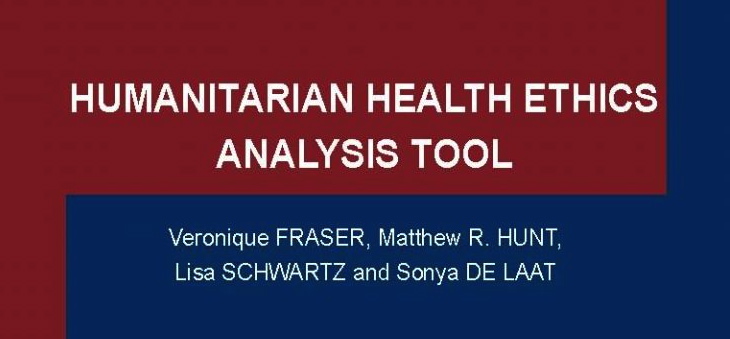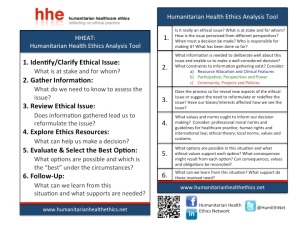The HHEAT was developed with the goal of supporting humanitarian health workers faced with an ethically challenging situation. It can be used in pre-departure training to work through common cases and scenarios, in humanitarian settings when ethical issues arise, or in debriefing sessions after particularly difficult decisions.
Humanitarian healthcare workers are trusted to provide support and assistance to vulnerable groups and populations. This relationship means that humanitarians have a responsibility towards those to whom they provide care and assistance, and an obligation to consider how and why they make choices. The Humanitarian Health Ethics Analysis Tool (HHEAT) was designed to provide an accessible resource to support people involved in the process of analyzing and responding to an ethically challenging situation related to healthcare in the context of a humanitarian response. The development of the HHEAT was inspired by stories told by humanitarian healthcare workers about the challenges they had experienced working in a range of humanitarian settings. The tool responds to some of the key themes emerging from these narratives and seeks to draw attention to ethical features of humanitarian aid contexts.
The aim of ethical deliberation is not necessarily to claim that there is one ‘right’ answer to many challenging ethical issues, but to enrich discussion of what is ethically at stake in a particular situation, consider multiple perspectives, and articulate reasons why a decision was made to adopt one course of action over another. Moral justification is an important part of assuming moral responsibility and accountability, both of which are essential to humanitarianism.
The HHEAT offers a structure that can help to foster a more comprehensive and systematic approach to ethical analysis and engagement with a range of perspectives. Within this structure, those using the HHEAT will draw in other sources relevant to the situation and context, including local norms and values; national, international and human rights law; professional moral norms; organizational and sectoral policies and guidelines; and ethical theories, amongst others.
Components of the HHEAT
- Quick reference card highlighting key questions. Available in English, French and Spanish.
- Handbook providing a detailed overview of the HHEAT, including explanations of the steps of the analysis process.
- Worksheet outlining key steps and providing space for recording the deliberative process.
The development of the HHEAT is summarized in the handbook and presented in greater detail in an article.The structure of the HHEAT draws on existing ethics analysis tools from other domains and was adapted with the goal of highlighting features relevant to humanitarian contexts. A key component of its development was vignette-based simulations in small groups with Canadian humanitarian workers. It has subsequently been used in a range of training contexts. Feedback was also received by researchers from outside our team who presented it at workshops with humanitarian workers in Jordan and Turkey
HHEAT Handbook at a Glance
How to Use the Tool
Moral Context of Humanitarian Aid
Step1: Identify/Clarify the Ethical Issue
Step 2: Gather Information
Step 3: Review the Ethical Issue
Step 4: Explore Ethics Resources
Step 5: Evaluate and Select the Best Option
Step 6: Follow Up
Bibliography
Download a Quick Reference Version of the HHEAT
Acknowledgements
Funding for this project was provided by the Canadian Institutes of Health Research (CIHR).
Graphic design was supported by the Centre for Interdisciplinary Research in Rehabilitation of Greater Montreal (CRIR).
The authors are grateful for the input and assistance of Nancy Johnson, Renaud Boulanger, Cathy Tansey, Anne Hudon; for the graphic design by Paule Samson; and for the research participants who contributed to evaluating the HHEAT.
HHEAT Handbook cover photo: Lynda Redwood-Campbell
Recommended Citation: Fraser V, Hunt MR, Schwartz L, de Laat S. 2014. Humanitarian Health Ethics Analysis Tool: HHEAT Handbook. ISBN: 978-0-9938354-0-7. Accessed (date) from www.humanitarianhealthethics.net.



Ethique collective, répartition des ressources car le fait de définir une cible